

Mrs. Brice's Nelson Cruise Logs |
|
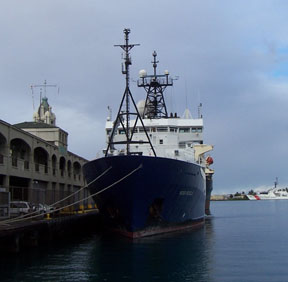 The R/V Revelle fueling in Hawaii the |
Mrs. Brice sailed from Honolulu, Hawaii September 2nd aboard the R/V Revelle to participate in the Nelson Cruise conducting plankton research in the area of the equator. The Revelle will return October 1st. Additional photos can be viewed on the Photo Album page.
Mrs. Brice's Daily Logs
|
|
September 3, 2005: Log #2 Log #2 Summary: Position: Lat: N15-55, LONG: W152-36 Travel time is spent learning how to operate the CTD that will be used to sample the sea water. Sampling will test for very minute amounts of trace minerals, so preventing comtamination from the ship environment will be very important and require special handling of the samples. the |
|
September 4, 2005: Log #3 Log #3 Summary: Position: Lat: 15-34.7N, LONG: 152-13.7W We are still enroute to our first station. The day is spent on assembling equipment, science meetings and working on lesson plans. A brief preview of some of the technology that will be used to communicate with the class and how it will be used for the students to view plankton being seen through the digital microscope on the ship. the |
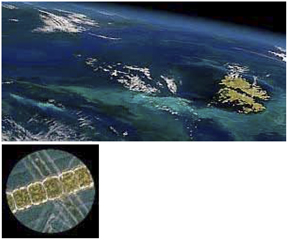 Plankton in the ocean as seen from space and through a microscope xxx |
September 5, 2005: Log #4 Log #4 Summary: Position: Lat: 12-39.5N, LONG: 149-06.0W Scientists on board will present data collected on the cruise last year. Many colors are visible in the ocean and those colors may reveal the presence and concentration of phytoplankton, sediments and dissolved organic chemicals. For most of the world's oceans, phytoplankton are the most important things that influence their color. Phytoplankton play a key role in the ecology of the marine ecosystem and changes in their patterns of distribution and abundance can effect the whole system. |
 Dr. Measures and his CTD for Fe and Al sampling xxx |
September 6, 2005: Log #5 Log #5 Summary: Position: Lat: 9-53.0N, LONG: 146-09.6W This cruise encompasses aspects of biology, chemistry, and geology as we explore what silica, iron and aluminum in seawater have to do with plankton. All of these subjects are part of the marine carbon cycle, so does this mean that the oceans are a source of CO2, adding it to the atmosphere, or a sink, removing it from the atmosphere? |
 Carbon cycling in the oceans xxx |
September 7, 2005: Log #6 Log #6 Summary: Position: Lat: 6-49.2N, LONG: 142-53.5W Today's log discusses Ocean Biology: Phytoplankton in Biospheric Processes with information, photographs, charts, and illustrations from NASA's SeaWifs Workshop. Links can be found in the log. We are still enroute to the first station. |
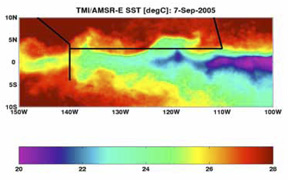 Seasurface profile of a Tropical Instability Wave (double click on the chart to view a video clip of a TIW) xxx |
September 8, 2005: Log #7 The convergence of warm and colder currents at the equator creates a sheer which in turn helps to create a Tropical Instability Wave. Double click on the image at the left to see a video clip of a TIW. |
 Deploying a plankton net xxx |
September 9, 2005: Log #8 Log #8 Summary: Position: Lat: 3-45.6N, LONG: 140-00.0W Upwelling of cold, nutrient-rich water at the Equatorial Divergence supports a highly productive phytoplankton community. Phytoplankton productivity is an important measure of the oceans' food supplies and are thought to be significant in the global carbon cycle. |
|
September 10, 2005: Log #9 Log #9 Summary: Position: Lat: 2-29.8N, LONG: 139-59.9W Of the several different groups of scientists on board, most are using the CTD rosette to collect their samples. Some are sampling for phytoplankton, which are too small to be caught in the mesh of the plankton net. When sampling for phytoplankton, the CTD allows for sampling from several depths with very accurate records of when, where, and the conditions under which the samples were taken. Other groups are sampling for Nitrates and Silica. |
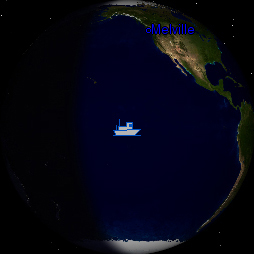 R/V Revelle's position 1° north of the equator xxx |
September 11, 2005: Log #10 Log #10 Summary: Position: Lat: 1-00-0N, LONG: 140-00.0W As you can see, we are just one degree north of the equator and we are heading north. It is a very big deal to cross the equator on a ship and there are very serious ceremonies aboard for those who have never "Crossed the Line" before. Those who have already crossed are called "Shellbacks" and those who have never crossed before are called "Pollywogs". |
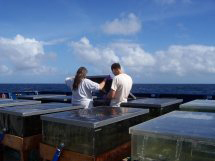 Checking the plankton incubators xxx |
September 12, 2005: Log #11 Log #11 Summary: Position: Lat: 0-30.0N, LONG: 140-00.0W Today we are on Station #7. Experiments are being conducted on the deck in plankton incubators. Some will have different nutrients added to the plankton such as iron, silica or germanium (a radioactive tracer). The scientists are looking at the individual effects of limiting or augmenting these nutrients on the growth rates of the phytoplankton. |
 Sea surface current chart at the equator xxx |
September 13, 2005: Log #12 The Acoustic Doppler Current Profiler equipment is experimental and is only aboard the R/V Revelle. |
 Plankton incubators with phytoplankton xxx |
September 14, 2005: Log #13 Log #13 Summary: Position: Lat: 0-30.0N, LONG: 140-00.0W We are on Station #11. Today's log discusses diatoms. Diatoms are a major component of plankton and are extremely abundant in both freshwater and marine ecosystems. It is estimated that 20% to 25% of ALL organic carbon fixation on the planet (transformation of carbon dioxide and water into sugars using light energy) is carried out by diatoms. They are a major food resource for marine and freshwater microorganisms and animal larvae. Diatoms are also a major source of atmospheric oxygen. |
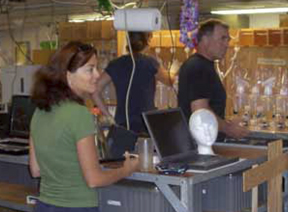 First broadcast from the main lab with Dr. Nelson xxx |
September 15, 2005: Log #14 We will also be able to show the students the effect of water pressure on styrofoam cups that they decorated. These were lowered into the ocean with the CTD where ocean pressure squeezed the air out of the styrofoam and shrank the cups to a much smaller size than they were originally! |
 Oceanic Whitetip shark xxx |
September 16, 2005: Log #15 An oceanic whitetip shark was seen from the ship. See the attached log for a description of their habits and distribution in the oceans. |
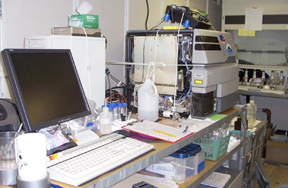 Flow Cytometer used by Dr. Karen Selph xxx |
September 17, 2005: Log #16 Log #16 Summary: Position: Lat: 1-59.0S, LONG: 137-38.1W We are en route to station #17. Dr. Landry's group and Dr. Dugdale's groups are using the Flow Cytometer to do plankton community analyses: The abundance of the biomass along with the size and structure of the component populations of the microplankton community are being analyzed using flow cytometer systems with different characteristics, augmented with microscopy. What is a Flow Cytometer? It characterizes particles in suspension, based on their light scatter properties and their auto- and induced fluorescent properties. |
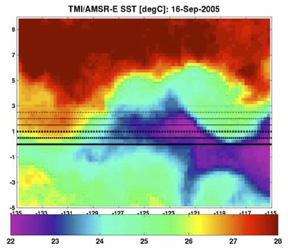 Our course along the equator and through the Tropical Instability Wave xxx |
September 18, 2005: Log #17 Log #17 Summary: Position: Lat: 0-00.0S, LONG: 133-55.6W We are on station #17 and a trace metal cast is in progress. So why are we looking at trace metals out here? We know that iron strongly affects the elemental composition of diatoms. Part of our objective is to distinguish among the roles of Fe limitation, Si limitation and zooplankton grazing in controlling floristic composition of the phytoplankton in the East Equatorial Pacific. Dr. Measures is sampling dissolved and particulate Fe in the research areas and is providing trace-metal free sea water for all shipboard experiments. He is also helping to interpret all experiments measuring phytoplankton response to Fe enrichment. His lab is one of the few in the world that cana reliably measure dissolved Fe at the <0.1nM concentrations found in much of the near surface ocean. |
 Micrograph of Rhizosolenia ready to divide xxx |
September 19, 2005: Log #18 Log #18 Summary: Position: Lat: 0-30.0N, LONG: 132-18.3W Mark Demarest and I have been experimenting with the compound PDMPO as a means to track siliton deposition in diatoms. All newly deposited Si appears fluoresce blue. The image at the left contains a Rhizosolenia cell as well as a long pennate near the top of the slide. Note the red scale bar. These are big cells. We see, that during incubation of about 10 hours, the cell deposited a large number of intercalary bands that add up to about half of the total length of the cell. This implies that the cell is ready to divide. Assuming a constant rate of Si deposition during the cell cycle, this cell underwent most of its division cycle during the incubation--implying a doubling time of about half a day. That's pretty fast. |
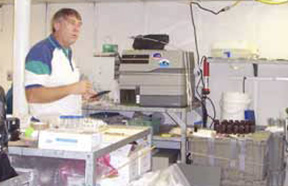 Dr. Landry shows the students the Flow Cytometer in a broadcast to the classroom xxx |
September 20, 2005: Log #19 Log #19 Summary: Position: Lat: 0-30.0N, LONG: 129-55.3W We are on station #19. We did a broadcast to San Marcos Middle School this morning. Dr. Nelson narrated a CTD cast for the students. He talked about how water is collected in the bottles and why it is necessary to use a CTD instead of a tow net for the particular samples he wants. Dr. Landry showed the students the Flow Cytometer, describing how it worked and what they were using it to do. He also explained methods for filtering the phytoplankton and the zooplankton. |
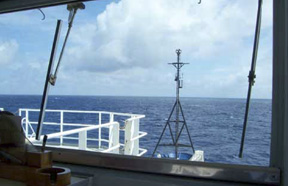 View of calm seas from the bridge of the Revelle xxx |
September 21, 2005: Log #20 Log #20 Summary: Position: Lat: 0-30.1N, LONG: 127-48.0W We are en route to station #21. Dr. Stephen Baines of Stonybrook University in New York is on board taking samples to look at individual cells and analyze their trace elements. He is working with a group of scientists from several other institutions to look at the plankton at the molecular level and determine concentrations of trace metals in individual cells and to show their location. By using the process of Synchrotron-based X-ray Fluorescence Microscopy they can see which individual species are using the materials and in what concentrations. |